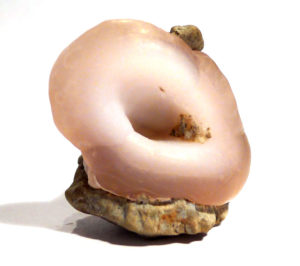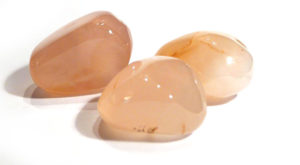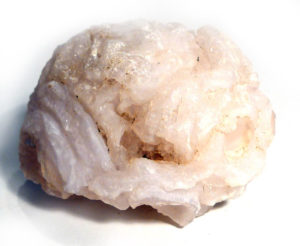Properties:
Chalcedony has a soft, sweet energy that smooths ruffled feathers, and nurtures and supports the user. Most have an “otherness” – a sense of existing in several dimensions at once, or straddling this world and the “Other World”, so most are excellent for working interdimensionally, and with angelic and nature energy. A possible exception is carnelian – understandable with its inclusion of iron oxide, but even in this case it has a dual nature. It is well known for its fiery energy, which instils courage, motivation, energy and happiness, but it also brings attention to the Tan T’ien, and so doing helps to ground spiritual energy, calm busy mind and aid inner stillness.
As you might expect, the energy of pink chalcedony bears a close resemblance to that of rose quartz. It definitely aligns with the Heart Chakra and its main quality is to encourage love. However, unlike the slightly earthier physicality of rose quartz, its quality is softer, gentler and smoother, and the vibration higher and of a more heavenly dimension. It opens our hearts to divine love, gently releases emotional pain, and helps ease the pain of separation from Source and the longing for our spiritual home. The high vibration also connects with the Angelic realm, enabling Angelic communication and understanding. Pink chalcedony softens the aftermath of traumatic events, especially when used in conjunction with girasole quartz, making it easier to let go and move on. Michael Gienger says it encourages warm-heartedness.
Attributes:
- Chemical Formula: SiO2 – quartz
- Group: Silicates – tectosilicates
- Crystal System: Trigonal/Hexagonal
- Hardness: 7
- Birthstone: Elemental signs of Cancer and Sagittarius (according to Melody)
- Chakra: Heart
- Element: Water and Spirit
Mineralogy:
Chalcedony is a microcrystalline variety of quartz. Quartz is subdivided into groups: macrocrystalline (such as quartz, amethyst, citrine, and smoky quartz), massive (rose quartz, aventurine and tiger’s eye), and microcrystalline. Microcrystalline quartz is further subdivided into the fibrous chalcedonies such as agate (when it displays banding), blue chalcedony, carnelian, chrysoprase, pink chalcedony and flint; and granular chalcedonies such as bloodstone and jasper. ‘Fibrous’ in this context simply means that the quartz crystals form as parallel microscopic fibres. Fibrous chalcedonies are translucent, and white in their purest form, but trace elements and microscopic inclusions give them a wide range of colours. Habit may be maxillary (breast-like), botryoidal (resembling a bunch of grapes), or stalactitic (forming as stalactites and stalagmites). They form in geodes, veins and concretions when low-temperature, silica-rich waters percolate through existing rocks, particularly volcanic rocks (bear in mind, low temperature in this instance is still extremely hot!). Chalcedony can be any colour due to embedded minerals, and multi-coloured specimen are not uncommon. Being relatively porous, it is frequently dyed to improve its marketability.
History and Tradition:
The name ‘chalcedony’ was first mentioned by Agricola in 1546, regarding a stone named after the town of Chalcedon, now modern-day Kadıköy, a district within the city of Istanbul, Turkey. Some individual varieties are associated with specific history and tradition.



